Wesfarmers & Woolworths: A Corporate Accounting Comparative Analysis
VerifiedAdded on 2023/06/05
|27
|5012
|116
Report
AI Summary
This report provides a comprehensive corporate accounting analysis comparing Wesfarmers and Woolworths, two major Australian retailers, over a three-year period. It examines key financial statements, including owner's equity (share capital, reserves, and retained profits), cash flow statements (operating, investing, and financing activities), and the comprehensive income statement. The analysis includes a comparative assessment of these elements, focusing on trends and significant differences between the two companies. Specific items like cash flow from operations, changes in working capital, capital expenditures, and the treatment of corporate income tax are discussed in detail to provide a thorough understanding of the financial performance and position of each firm. The report highlights the importance of analyzing these financial statements for investors and stakeholders to assess the companies' financial health and future prospects. Desklib provides this document and many other solved assignments for students.
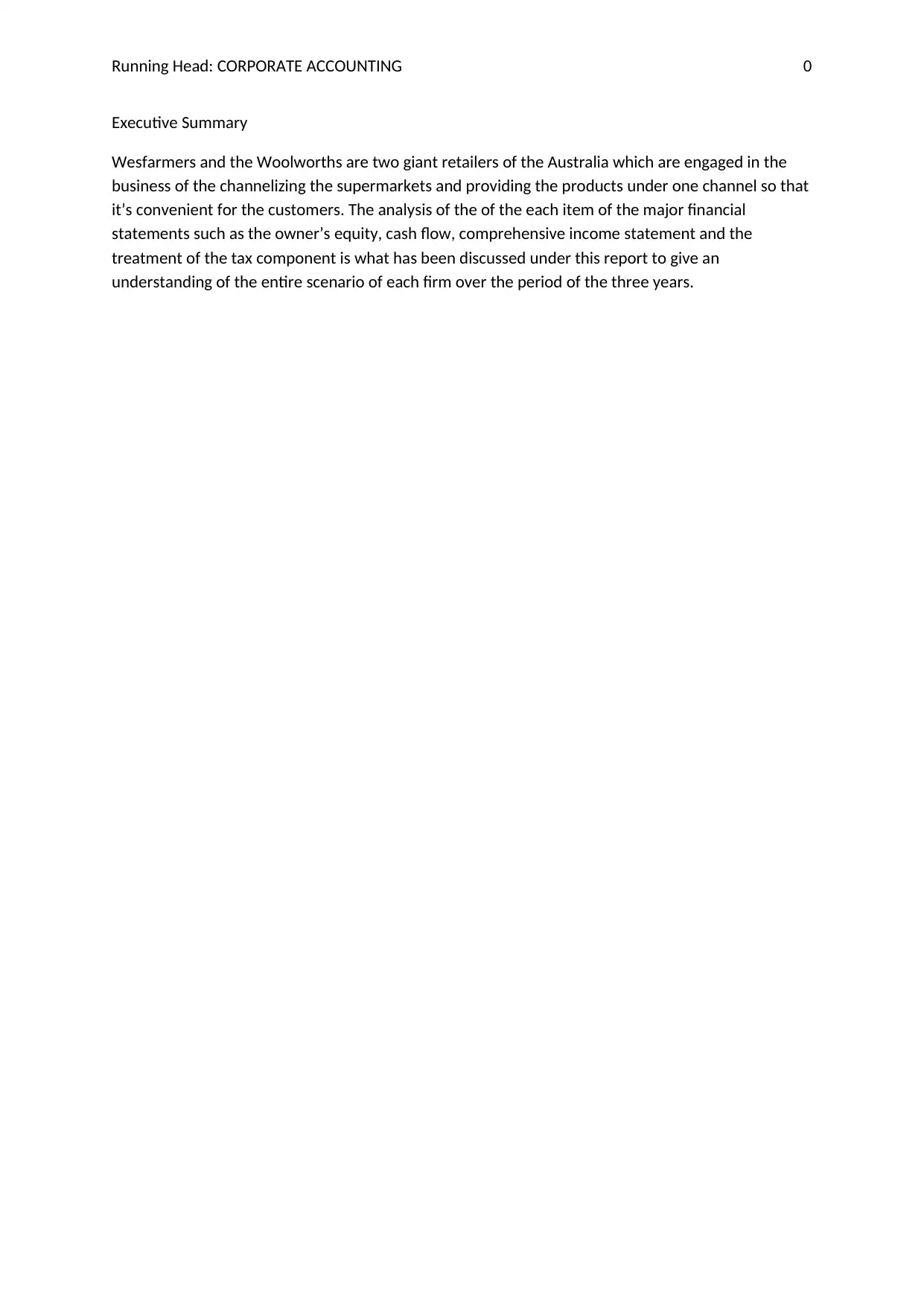
Running Head: CORPORATE ACCOUNTING 0
Executive Summary
Wesfarmers and the Woolworths are two giant retailers of the Australia which are engaged in the
business of the channelizing the supermarkets and providing the products under one channel so that
it’s convenient for the customers. The analysis of the of the each item of the major financial
statements such as the owner’s equity, cash flow, comprehensive income statement and the
treatment of the tax component is what has been discussed under this report to give an
understanding of the entire scenario of each firm over the period of the three years.
Executive Summary
Wesfarmers and the Woolworths are two giant retailers of the Australia which are engaged in the
business of the channelizing the supermarkets and providing the products under one channel so that
it’s convenient for the customers. The analysis of the of the each item of the major financial
statements such as the owner’s equity, cash flow, comprehensive income statement and the
treatment of the tax component is what has been discussed under this report to give an
understanding of the entire scenario of each firm over the period of the three years.
Paraphrase This Document
Need a fresh take? Get an instant paraphrase of this document with our AI Paraphraser
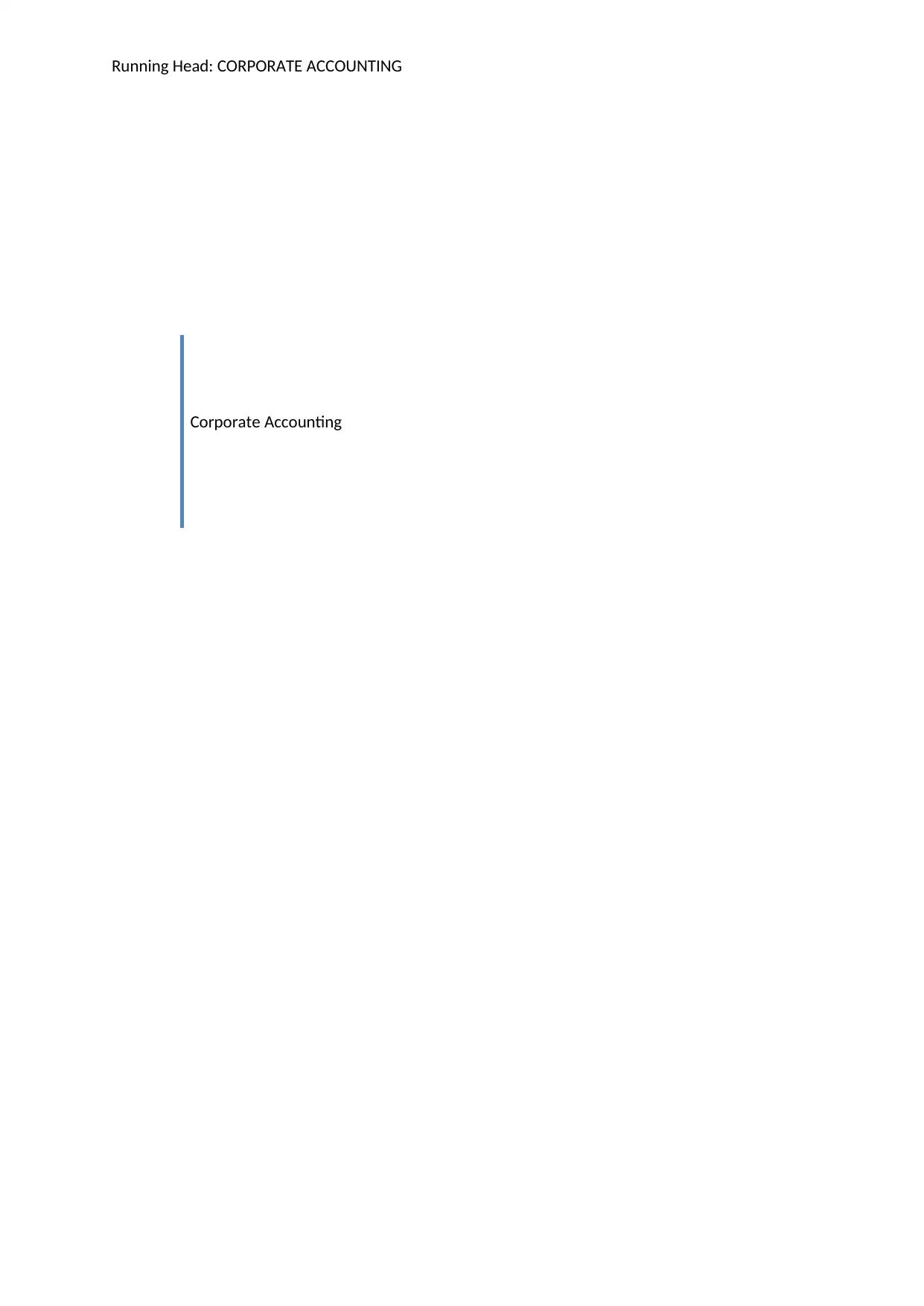
Running Head: CORPORATE ACCOUNTING
Corporate Accounting
Corporate Accounting
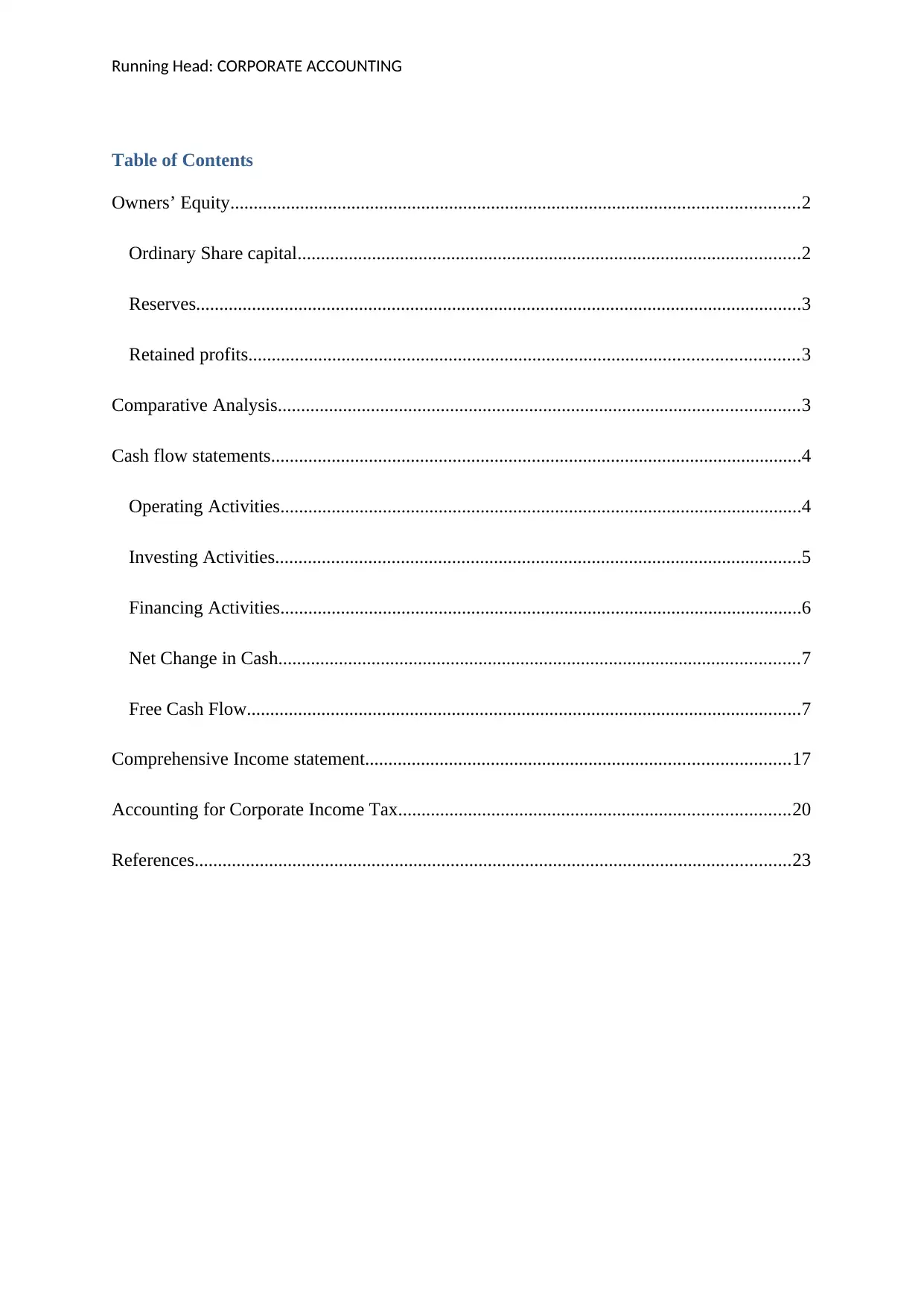
Running Head: CORPORATE ACCOUNTING
Table of Contents
Owners’ Equity..........................................................................................................................2
Ordinary Share capital............................................................................................................2
Reserves..................................................................................................................................3
Retained profits......................................................................................................................3
Comparative Analysis................................................................................................................3
Cash flow statements..................................................................................................................4
Operating Activities................................................................................................................4
Investing Activities.................................................................................................................5
Financing Activities................................................................................................................6
Net Change in Cash................................................................................................................7
Free Cash Flow.......................................................................................................................7
Comprehensive Income statement...........................................................................................17
Accounting for Corporate Income Tax....................................................................................20
References................................................................................................................................23
Table of Contents
Owners’ Equity..........................................................................................................................2
Ordinary Share capital............................................................................................................2
Reserves..................................................................................................................................3
Retained profits......................................................................................................................3
Comparative Analysis................................................................................................................3
Cash flow statements..................................................................................................................4
Operating Activities................................................................................................................4
Investing Activities.................................................................................................................5
Financing Activities................................................................................................................6
Net Change in Cash................................................................................................................7
Free Cash Flow.......................................................................................................................7
Comprehensive Income statement...........................................................................................17
Accounting for Corporate Income Tax....................................................................................20
References................................................................................................................................23
⊘ This is a preview!⊘
Do you want full access?
Subscribe today to unlock all pages.

Trusted by 1+ million students worldwide
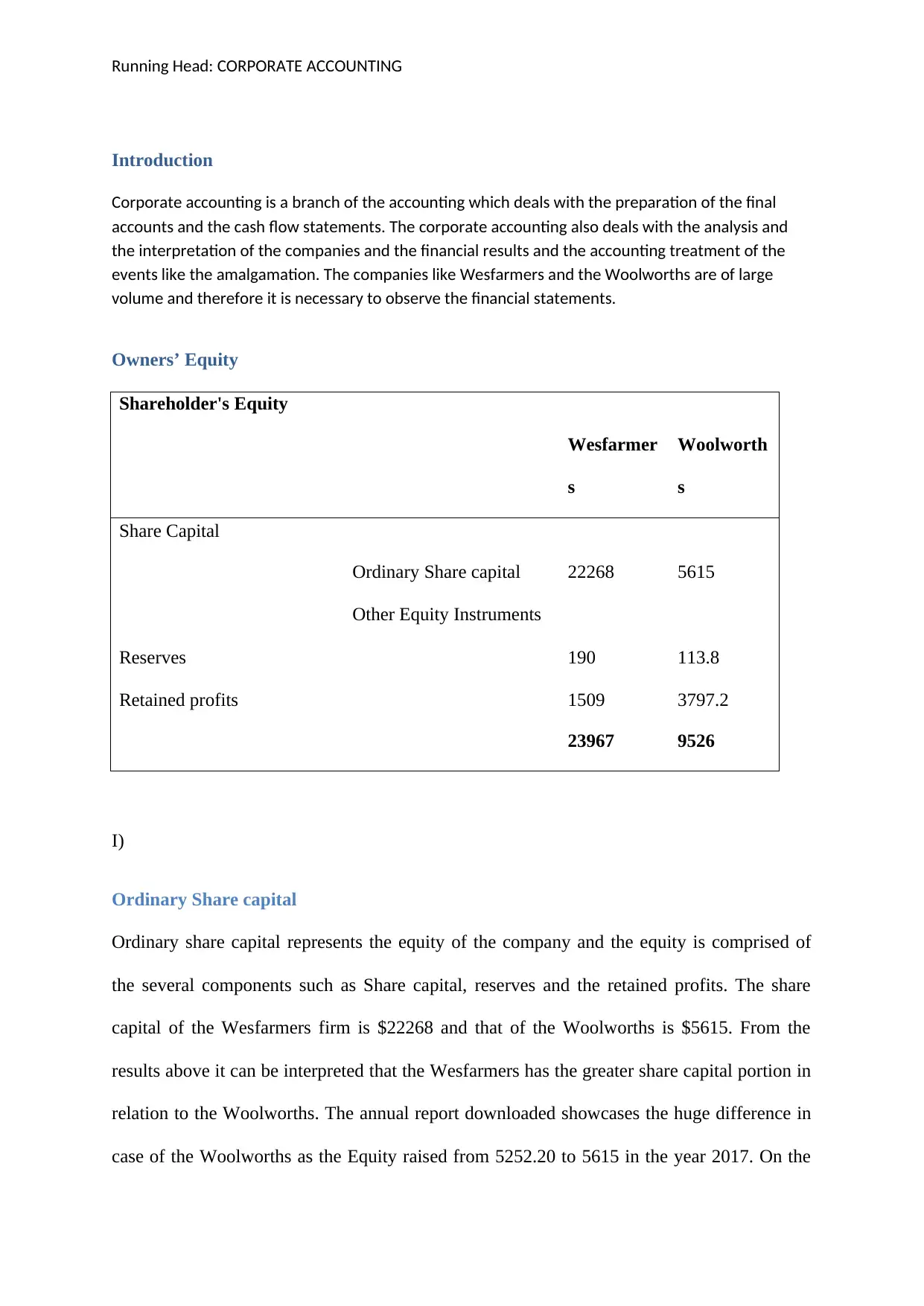
Running Head: CORPORATE ACCOUNTING
Introduction
Corporate accounting is a branch of the accounting which deals with the preparation of the final
accounts and the cash flow statements. The corporate accounting also deals with the analysis and
the interpretation of the companies and the financial results and the accounting treatment of the
events like the amalgamation. The companies like Wesfarmers and the Woolworths are of large
volume and therefore it is necessary to observe the financial statements.
Owners’ Equity
Shareholder's Equity
Wesfarmer
s
Woolworth
s
Share Capital
Ordinary Share capital 22268 5615
Other Equity Instruments
Reserves 190 113.8
Retained profits 1509 3797.2
23967 9526
I)
Ordinary Share capital
Ordinary share capital represents the equity of the company and the equity is comprised of
the several components such as Share capital, reserves and the retained profits. The share
capital of the Wesfarmers firm is $22268 and that of the Woolworths is $5615. From the
results above it can be interpreted that the Wesfarmers has the greater share capital portion in
relation to the Woolworths. The annual report downloaded showcases the huge difference in
case of the Woolworths as the Equity raised from 5252.20 to 5615 in the year 2017. On the
Introduction
Corporate accounting is a branch of the accounting which deals with the preparation of the final
accounts and the cash flow statements. The corporate accounting also deals with the analysis and
the interpretation of the companies and the financial results and the accounting treatment of the
events like the amalgamation. The companies like Wesfarmers and the Woolworths are of large
volume and therefore it is necessary to observe the financial statements.
Owners’ Equity
Shareholder's Equity
Wesfarmer
s
Woolworth
s
Share Capital
Ordinary Share capital 22268 5615
Other Equity Instruments
Reserves 190 113.8
Retained profits 1509 3797.2
23967 9526
I)
Ordinary Share capital
Ordinary share capital represents the equity of the company and the equity is comprised of
the several components such as Share capital, reserves and the retained profits. The share
capital of the Wesfarmers firm is $22268 and that of the Woolworths is $5615. From the
results above it can be interpreted that the Wesfarmers has the greater share capital portion in
relation to the Woolworths. The annual report downloaded showcases the huge difference in
case of the Woolworths as the Equity raised from 5252.20 to 5615 in the year 2017. On the
Paraphrase This Document
Need a fresh take? Get an instant paraphrase of this document with our AI Paraphraser
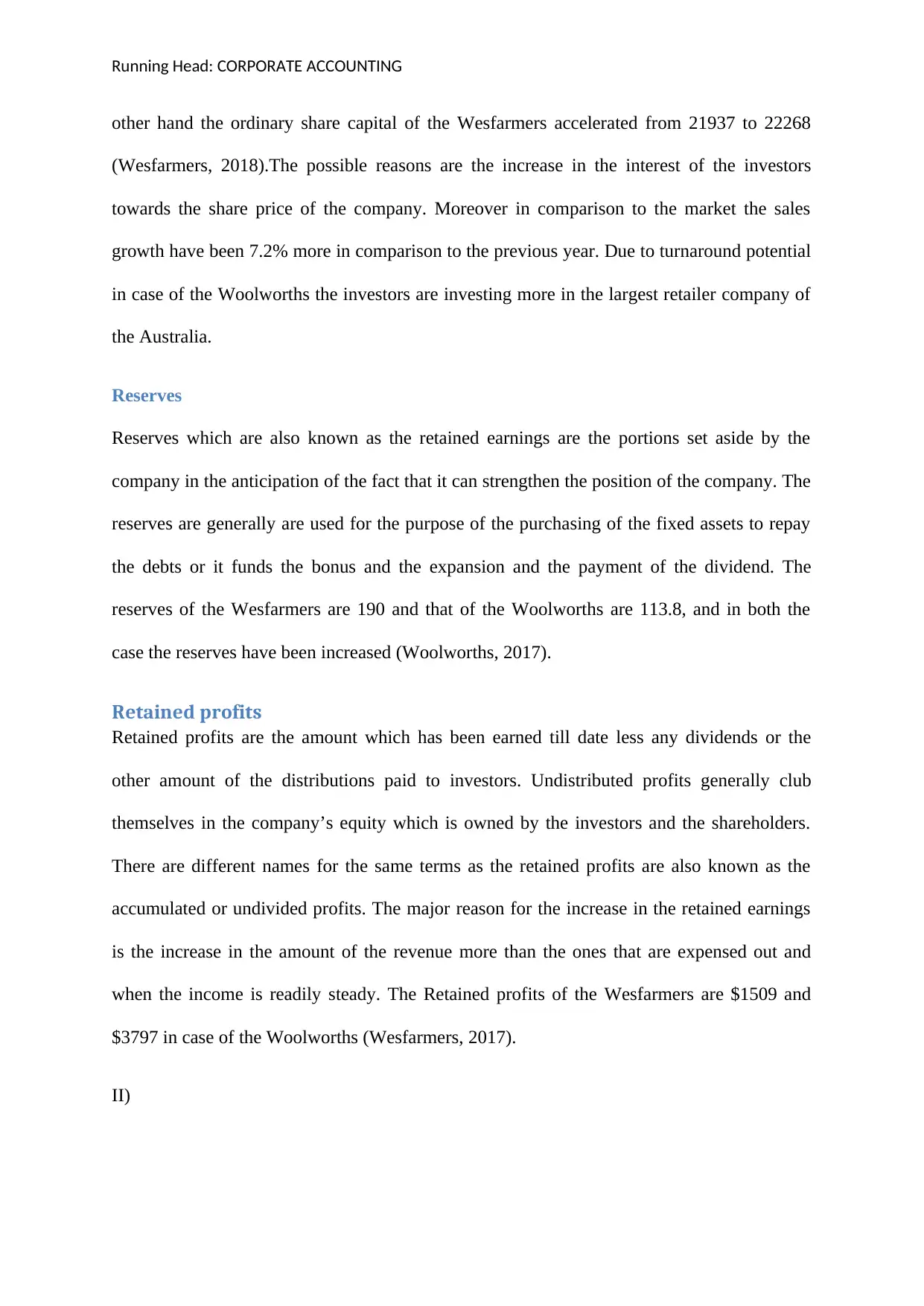
Running Head: CORPORATE ACCOUNTING
other hand the ordinary share capital of the Wesfarmers accelerated from 21937 to 22268
(Wesfarmers, 2018).The possible reasons are the increase in the interest of the investors
towards the share price of the company. Moreover in comparison to the market the sales
growth have been 7.2% more in comparison to the previous year. Due to turnaround potential
in case of the Woolworths the investors are investing more in the largest retailer company of
the Australia.
Reserves
Reserves which are also known as the retained earnings are the portions set aside by the
company in the anticipation of the fact that it can strengthen the position of the company. The
reserves are generally are used for the purpose of the purchasing of the fixed assets to repay
the debts or it funds the bonus and the expansion and the payment of the dividend. The
reserves of the Wesfarmers are 190 and that of the Woolworths are 113.8, and in both the
case the reserves have been increased (Woolworths, 2017).
Retained profits
Retained profits are the amount which has been earned till date less any dividends or the
other amount of the distributions paid to investors. Undistributed profits generally club
themselves in the company’s equity which is owned by the investors and the shareholders.
There are different names for the same terms as the retained profits are also known as the
accumulated or undivided profits. The major reason for the increase in the retained earnings
is the increase in the amount of the revenue more than the ones that are expensed out and
when the income is readily steady. The Retained profits of the Wesfarmers are $1509 and
$3797 in case of the Woolworths (Wesfarmers, 2017).
II)
other hand the ordinary share capital of the Wesfarmers accelerated from 21937 to 22268
(Wesfarmers, 2018).The possible reasons are the increase in the interest of the investors
towards the share price of the company. Moreover in comparison to the market the sales
growth have been 7.2% more in comparison to the previous year. Due to turnaround potential
in case of the Woolworths the investors are investing more in the largest retailer company of
the Australia.
Reserves
Reserves which are also known as the retained earnings are the portions set aside by the
company in the anticipation of the fact that it can strengthen the position of the company. The
reserves are generally are used for the purpose of the purchasing of the fixed assets to repay
the debts or it funds the bonus and the expansion and the payment of the dividend. The
reserves of the Wesfarmers are 190 and that of the Woolworths are 113.8, and in both the
case the reserves have been increased (Woolworths, 2017).
Retained profits
Retained profits are the amount which has been earned till date less any dividends or the
other amount of the distributions paid to investors. Undistributed profits generally club
themselves in the company’s equity which is owned by the investors and the shareholders.
There are different names for the same terms as the retained profits are also known as the
accumulated or undivided profits. The major reason for the increase in the retained earnings
is the increase in the amount of the revenue more than the ones that are expensed out and
when the income is readily steady. The Retained profits of the Wesfarmers are $1509 and
$3797 in case of the Woolworths (Wesfarmers, 2017).
II)
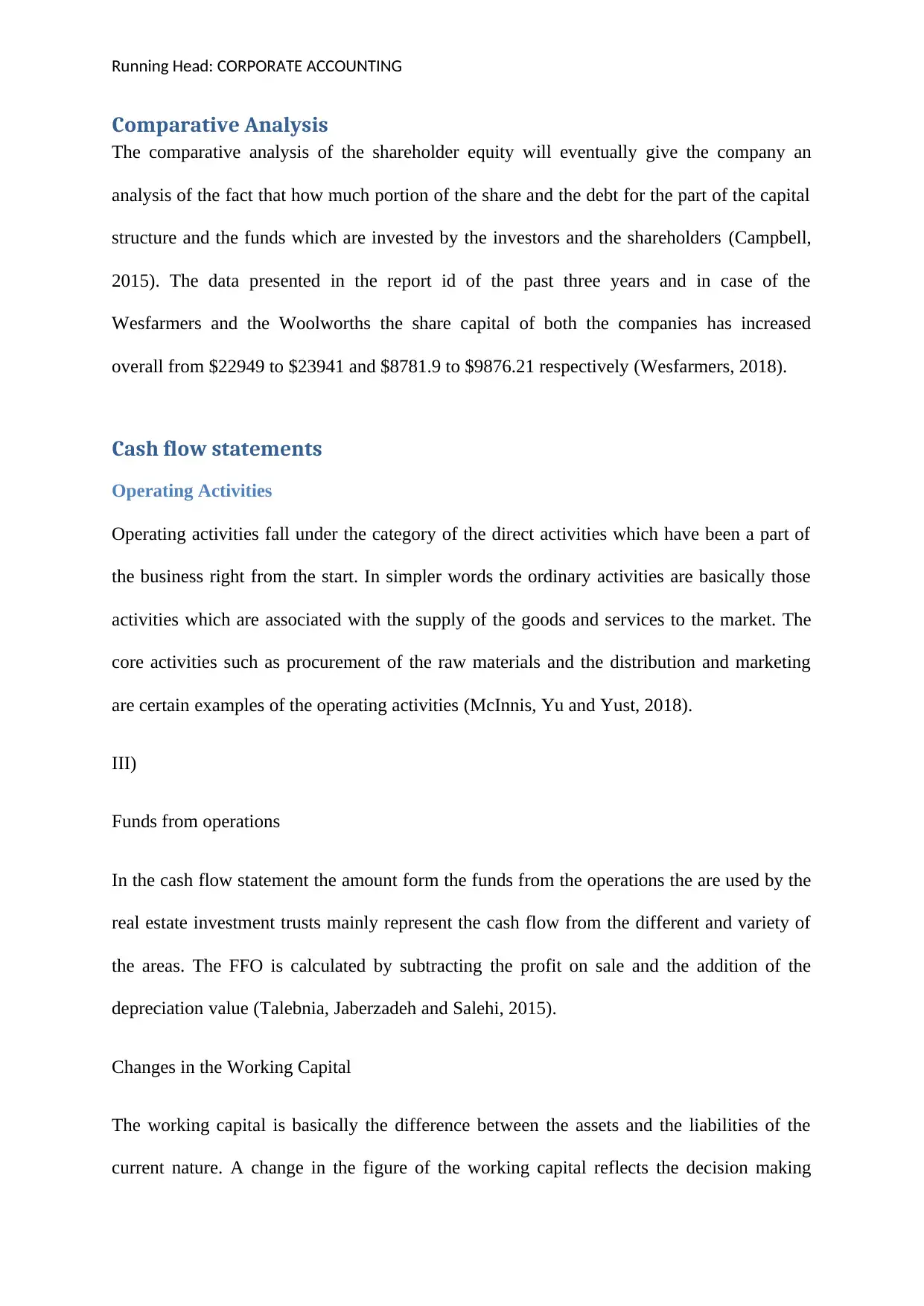
Running Head: CORPORATE ACCOUNTING
Comparative Analysis
The comparative analysis of the shareholder equity will eventually give the company an
analysis of the fact that how much portion of the share and the debt for the part of the capital
structure and the funds which are invested by the investors and the shareholders (Campbell,
2015). The data presented in the report id of the past three years and in case of the
Wesfarmers and the Woolworths the share capital of both the companies has increased
overall from $22949 to $23941 and $8781.9 to $9876.21 respectively (Wesfarmers, 2018).
Cash flow statements
Operating Activities
Operating activities fall under the category of the direct activities which have been a part of
the business right from the start. In simpler words the ordinary activities are basically those
activities which are associated with the supply of the goods and services to the market. The
core activities such as procurement of the raw materials and the distribution and marketing
are certain examples of the operating activities (McInnis, Yu and Yust, 2018).
III)
Funds from operations
In the cash flow statement the amount form the funds from the operations the are used by the
real estate investment trusts mainly represent the cash flow from the different and variety of
the areas. The FFO is calculated by subtracting the profit on sale and the addition of the
depreciation value (Talebnia, Jaberzadeh and Salehi, 2015).
Changes in the Working Capital
The working capital is basically the difference between the assets and the liabilities of the
current nature. A change in the figure of the working capital reflects the decision making
Comparative Analysis
The comparative analysis of the shareholder equity will eventually give the company an
analysis of the fact that how much portion of the share and the debt for the part of the capital
structure and the funds which are invested by the investors and the shareholders (Campbell,
2015). The data presented in the report id of the past three years and in case of the
Wesfarmers and the Woolworths the share capital of both the companies has increased
overall from $22949 to $23941 and $8781.9 to $9876.21 respectively (Wesfarmers, 2018).
Cash flow statements
Operating Activities
Operating activities fall under the category of the direct activities which have been a part of
the business right from the start. In simpler words the ordinary activities are basically those
activities which are associated with the supply of the goods and services to the market. The
core activities such as procurement of the raw materials and the distribution and marketing
are certain examples of the operating activities (McInnis, Yu and Yust, 2018).
III)
Funds from operations
In the cash flow statement the amount form the funds from the operations the are used by the
real estate investment trusts mainly represent the cash flow from the different and variety of
the areas. The FFO is calculated by subtracting the profit on sale and the addition of the
depreciation value (Talebnia, Jaberzadeh and Salehi, 2015).
Changes in the Working Capital
The working capital is basically the difference between the assets and the liabilities of the
current nature. A change in the figure of the working capital reflects the decision making
⊘ This is a preview!⊘
Do you want full access?
Subscribe today to unlock all pages.

Trusted by 1+ million students worldwide
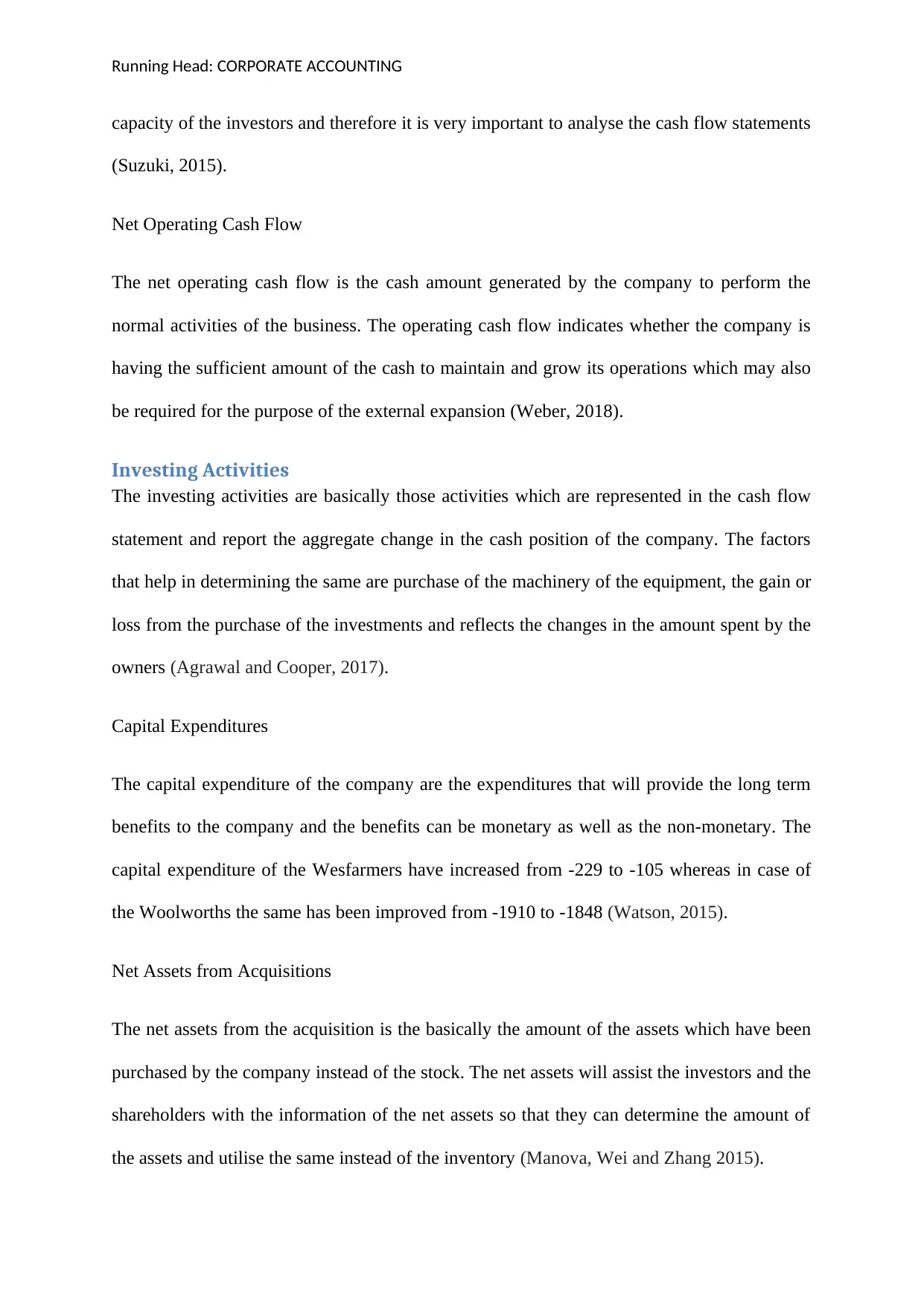
Running Head: CORPORATE ACCOUNTING
capacity of the investors and therefore it is very important to analyse the cash flow statements
(Suzuki, 2015).
Net Operating Cash Flow
The net operating cash flow is the cash amount generated by the company to perform the
normal activities of the business. The operating cash flow indicates whether the company is
having the sufficient amount of the cash to maintain and grow its operations which may also
be required for the purpose of the external expansion (Weber, 2018).
Investing Activities
The investing activities are basically those activities which are represented in the cash flow
statement and report the aggregate change in the cash position of the company. The factors
that help in determining the same are purchase of the machinery of the equipment, the gain or
loss from the purchase of the investments and reflects the changes in the amount spent by the
owners (Agrawal and Cooper, 2017).
Capital Expenditures
The capital expenditure of the company are the expenditures that will provide the long term
benefits to the company and the benefits can be monetary as well as the non-monetary. The
capital expenditure of the Wesfarmers have increased from -229 to -105 whereas in case of
the Woolworths the same has been improved from -1910 to -1848 (Watson, 2015).
Net Assets from Acquisitions
The net assets from the acquisition is the basically the amount of the assets which have been
purchased by the company instead of the stock. The net assets will assist the investors and the
shareholders with the information of the net assets so that they can determine the amount of
the assets and utilise the same instead of the inventory (Manova, Wei and Zhang 2015).
capacity of the investors and therefore it is very important to analyse the cash flow statements
(Suzuki, 2015).
Net Operating Cash Flow
The net operating cash flow is the cash amount generated by the company to perform the
normal activities of the business. The operating cash flow indicates whether the company is
having the sufficient amount of the cash to maintain and grow its operations which may also
be required for the purpose of the external expansion (Weber, 2018).
Investing Activities
The investing activities are basically those activities which are represented in the cash flow
statement and report the aggregate change in the cash position of the company. The factors
that help in determining the same are purchase of the machinery of the equipment, the gain or
loss from the purchase of the investments and reflects the changes in the amount spent by the
owners (Agrawal and Cooper, 2017).
Capital Expenditures
The capital expenditure of the company are the expenditures that will provide the long term
benefits to the company and the benefits can be monetary as well as the non-monetary. The
capital expenditure of the Wesfarmers have increased from -229 to -105 whereas in case of
the Woolworths the same has been improved from -1910 to -1848 (Watson, 2015).
Net Assets from Acquisitions
The net assets from the acquisition is the basically the amount of the assets which have been
purchased by the company instead of the stock. The net assets will assist the investors and the
shareholders with the information of the net assets so that they can determine the amount of
the assets and utilise the same instead of the inventory (Manova, Wei and Zhang 2015).
Paraphrase This Document
Need a fresh take? Get an instant paraphrase of this document with our AI Paraphraser
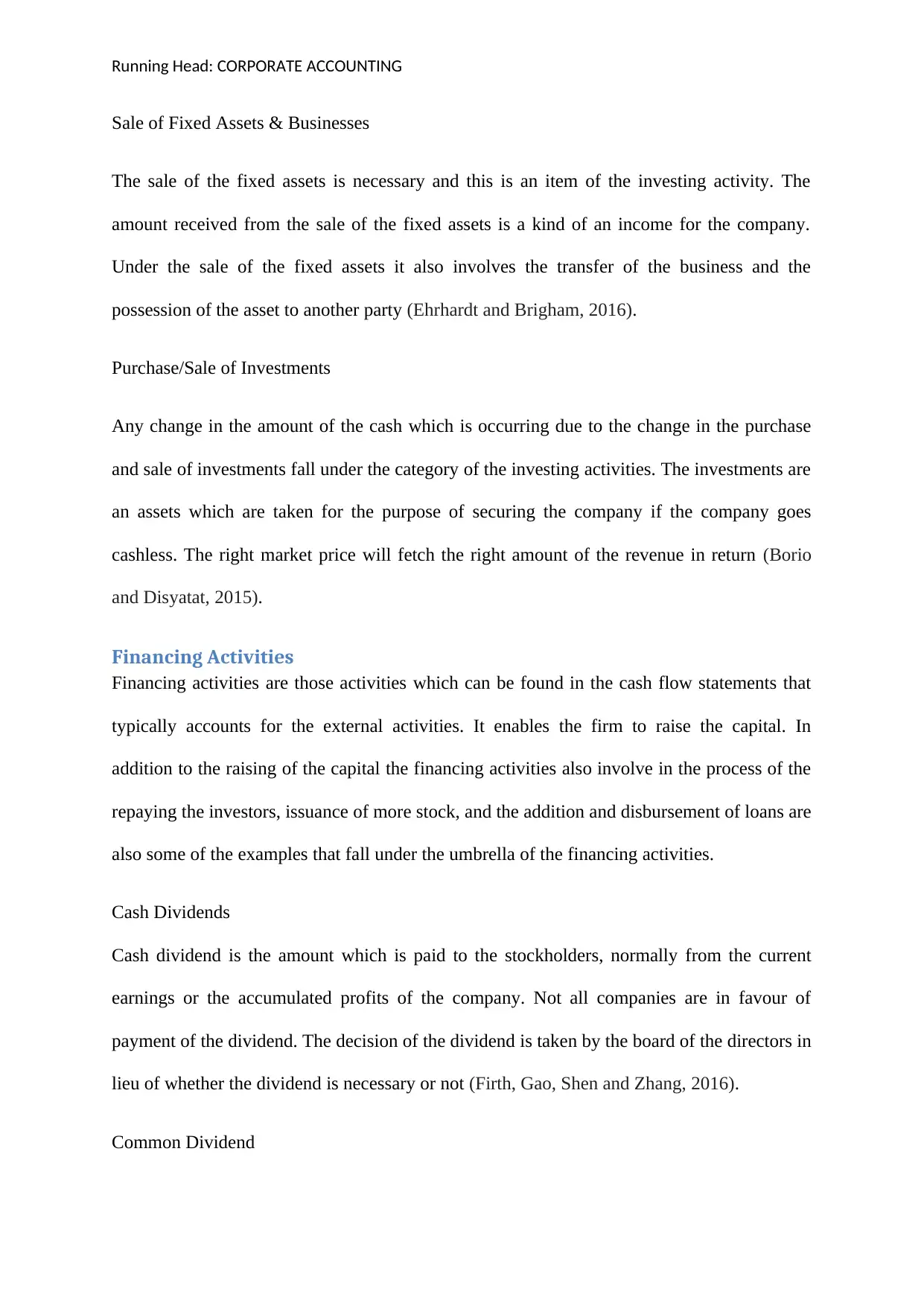
Running Head: CORPORATE ACCOUNTING
Sale of Fixed Assets & Businesses
The sale of the fixed assets is necessary and this is an item of the investing activity. The
amount received from the sale of the fixed assets is a kind of an income for the company.
Under the sale of the fixed assets it also involves the transfer of the business and the
possession of the asset to another party (Ehrhardt and Brigham, 2016).
Purchase/Sale of Investments
Any change in the amount of the cash which is occurring due to the change in the purchase
and sale of investments fall under the category of the investing activities. The investments are
an assets which are taken for the purpose of securing the company if the company goes
cashless. The right market price will fetch the right amount of the revenue in return (Borio
and Disyatat, 2015).
Financing Activities
Financing activities are those activities which can be found in the cash flow statements that
typically accounts for the external activities. It enables the firm to raise the capital. In
addition to the raising of the capital the financing activities also involve in the process of the
repaying the investors, issuance of more stock, and the addition and disbursement of loans are
also some of the examples that fall under the umbrella of the financing activities.
Cash Dividends
Cash dividend is the amount which is paid to the stockholders, normally from the current
earnings or the accumulated profits of the company. Not all companies are in favour of
payment of the dividend. The decision of the dividend is taken by the board of the directors in
lieu of whether the dividend is necessary or not (Firth, Gao, Shen and Zhang, 2016).
Common Dividend
Sale of Fixed Assets & Businesses
The sale of the fixed assets is necessary and this is an item of the investing activity. The
amount received from the sale of the fixed assets is a kind of an income for the company.
Under the sale of the fixed assets it also involves the transfer of the business and the
possession of the asset to another party (Ehrhardt and Brigham, 2016).
Purchase/Sale of Investments
Any change in the amount of the cash which is occurring due to the change in the purchase
and sale of investments fall under the category of the investing activities. The investments are
an assets which are taken for the purpose of securing the company if the company goes
cashless. The right market price will fetch the right amount of the revenue in return (Borio
and Disyatat, 2015).
Financing Activities
Financing activities are those activities which can be found in the cash flow statements that
typically accounts for the external activities. It enables the firm to raise the capital. In
addition to the raising of the capital the financing activities also involve in the process of the
repaying the investors, issuance of more stock, and the addition and disbursement of loans are
also some of the examples that fall under the umbrella of the financing activities.
Cash Dividends
Cash dividend is the amount which is paid to the stockholders, normally from the current
earnings or the accumulated profits of the company. Not all companies are in favour of
payment of the dividend. The decision of the dividend is taken by the board of the directors in
lieu of whether the dividend is necessary or not (Firth, Gao, Shen and Zhang, 2016).
Common Dividend
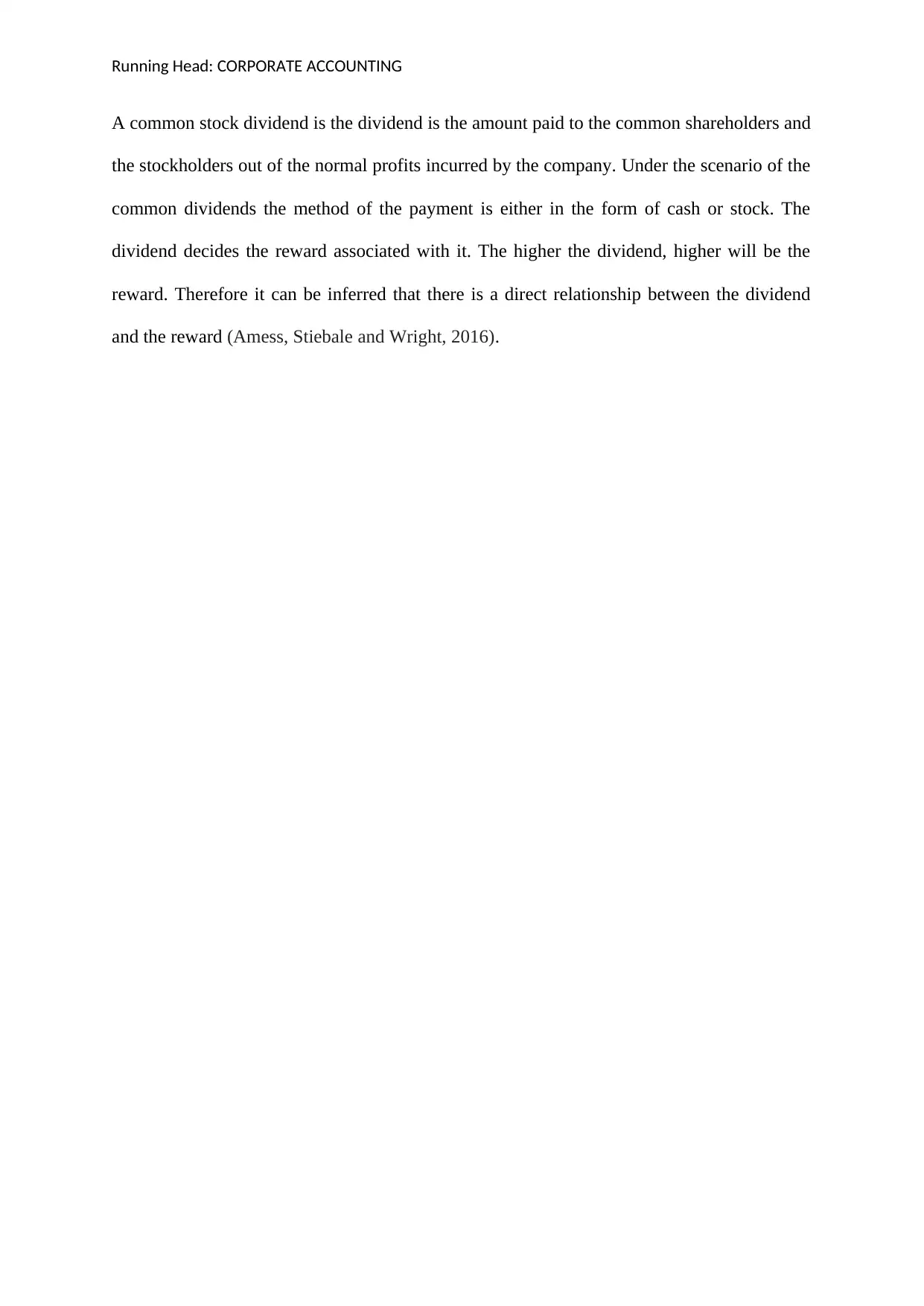
Running Head: CORPORATE ACCOUNTING
A common stock dividend is the dividend is the amount paid to the common shareholders and
the stockholders out of the normal profits incurred by the company. Under the scenario of the
common dividends the method of the payment is either in the form of cash or stock. The
dividend decides the reward associated with it. The higher the dividend, higher will be the
reward. Therefore it can be inferred that there is a direct relationship between the dividend
and the reward (Amess, Stiebale and Wright, 2016).
A common stock dividend is the dividend is the amount paid to the common shareholders and
the stockholders out of the normal profits incurred by the company. Under the scenario of the
common dividends the method of the payment is either in the form of cash or stock. The
dividend decides the reward associated with it. The higher the dividend, higher will be the
reward. Therefore it can be inferred that there is a direct relationship between the dividend
and the reward (Amess, Stiebale and Wright, 2016).
⊘ This is a preview!⊘
Do you want full access?
Subscribe today to unlock all pages.

Trusted by 1+ million students worldwide
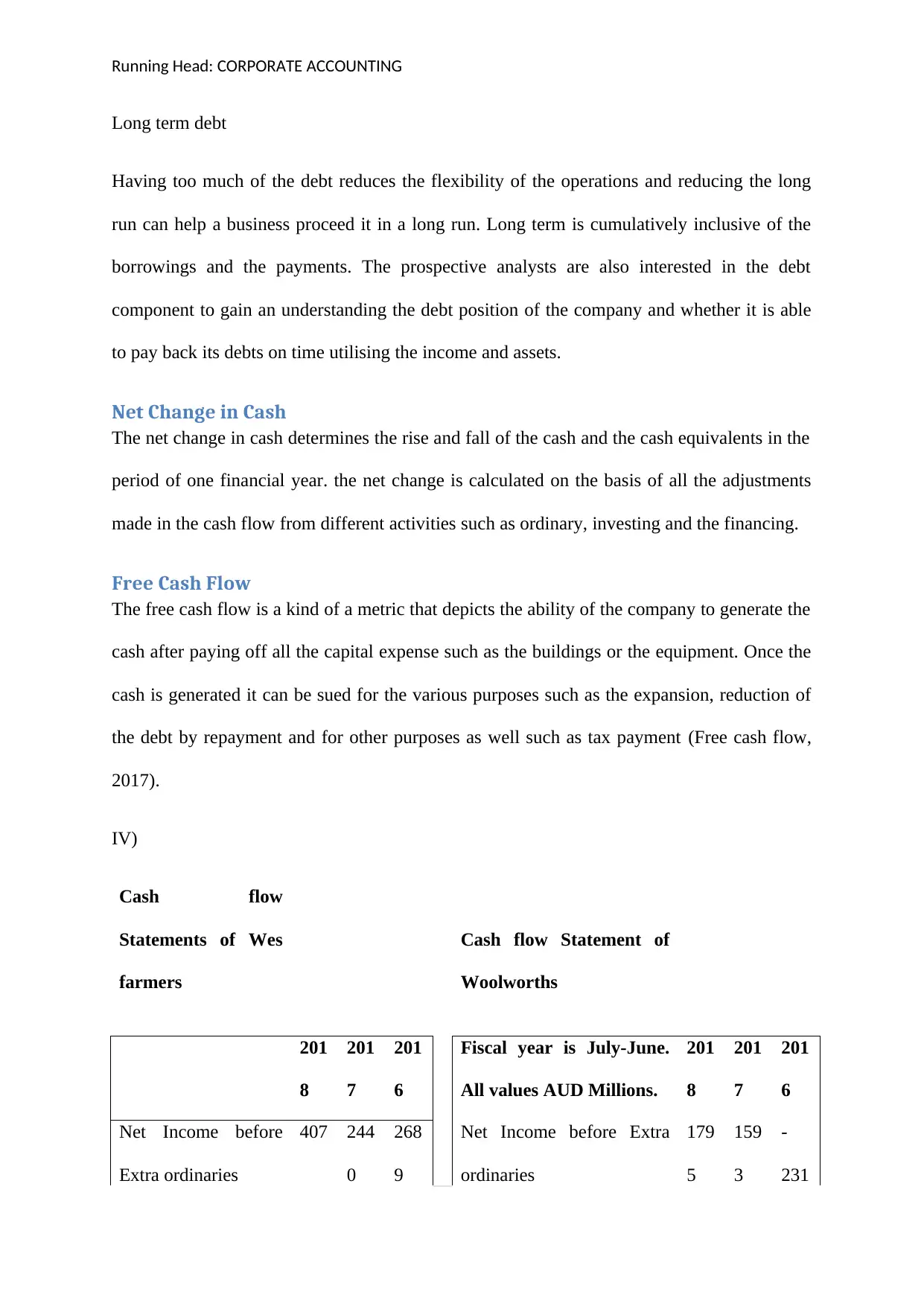
Running Head: CORPORATE ACCOUNTING
Long term debt
Having too much of the debt reduces the flexibility of the operations and reducing the long
run can help a business proceed it in a long run. Long term is cumulatively inclusive of the
borrowings and the payments. The prospective analysts are also interested in the debt
component to gain an understanding the debt position of the company and whether it is able
to pay back its debts on time utilising the income and assets.
Net Change in Cash
The net change in cash determines the rise and fall of the cash and the cash equivalents in the
period of one financial year. the net change is calculated on the basis of all the adjustments
made in the cash flow from different activities such as ordinary, investing and the financing.
Free Cash Flow
The free cash flow is a kind of a metric that depicts the ability of the company to generate the
cash after paying off all the capital expense such as the buildings or the equipment. Once the
cash is generated it can be sued for the various purposes such as the expansion, reduction of
the debt by repayment and for other purposes as well such as tax payment (Free cash flow,
2017).
IV)
Cash flow
Statements of Wes
farmers
Cash flow Statement of
Woolworths
201
8
201
7
201
6
Fiscal year is July-June.
All values AUD Millions.
201
8
201
7
201
6
Net Income before
Extra ordinaries
407 244
0
268
9
Net Income before Extra
ordinaries
179
5
159
3
-
231
Long term debt
Having too much of the debt reduces the flexibility of the operations and reducing the long
run can help a business proceed it in a long run. Long term is cumulatively inclusive of the
borrowings and the payments. The prospective analysts are also interested in the debt
component to gain an understanding the debt position of the company and whether it is able
to pay back its debts on time utilising the income and assets.
Net Change in Cash
The net change in cash determines the rise and fall of the cash and the cash equivalents in the
period of one financial year. the net change is calculated on the basis of all the adjustments
made in the cash flow from different activities such as ordinary, investing and the financing.
Free Cash Flow
The free cash flow is a kind of a metric that depicts the ability of the company to generate the
cash after paying off all the capital expense such as the buildings or the equipment. Once the
cash is generated it can be sued for the various purposes such as the expansion, reduction of
the debt by repayment and for other purposes as well such as tax payment (Free cash flow,
2017).
IV)
Cash flow
Statements of Wes
farmers
Cash flow Statement of
Woolworths
201
8
201
7
201
6
Fiscal year is July-June.
All values AUD Millions.
201
8
201
7
201
6
Net Income before
Extra ordinaries
407 244
0
268
9
Net Income before Extra
ordinaries
179
5
159
3
-
231
Paraphrase This Document
Need a fresh take? Get an instant paraphrase of this document with our AI Paraphraser
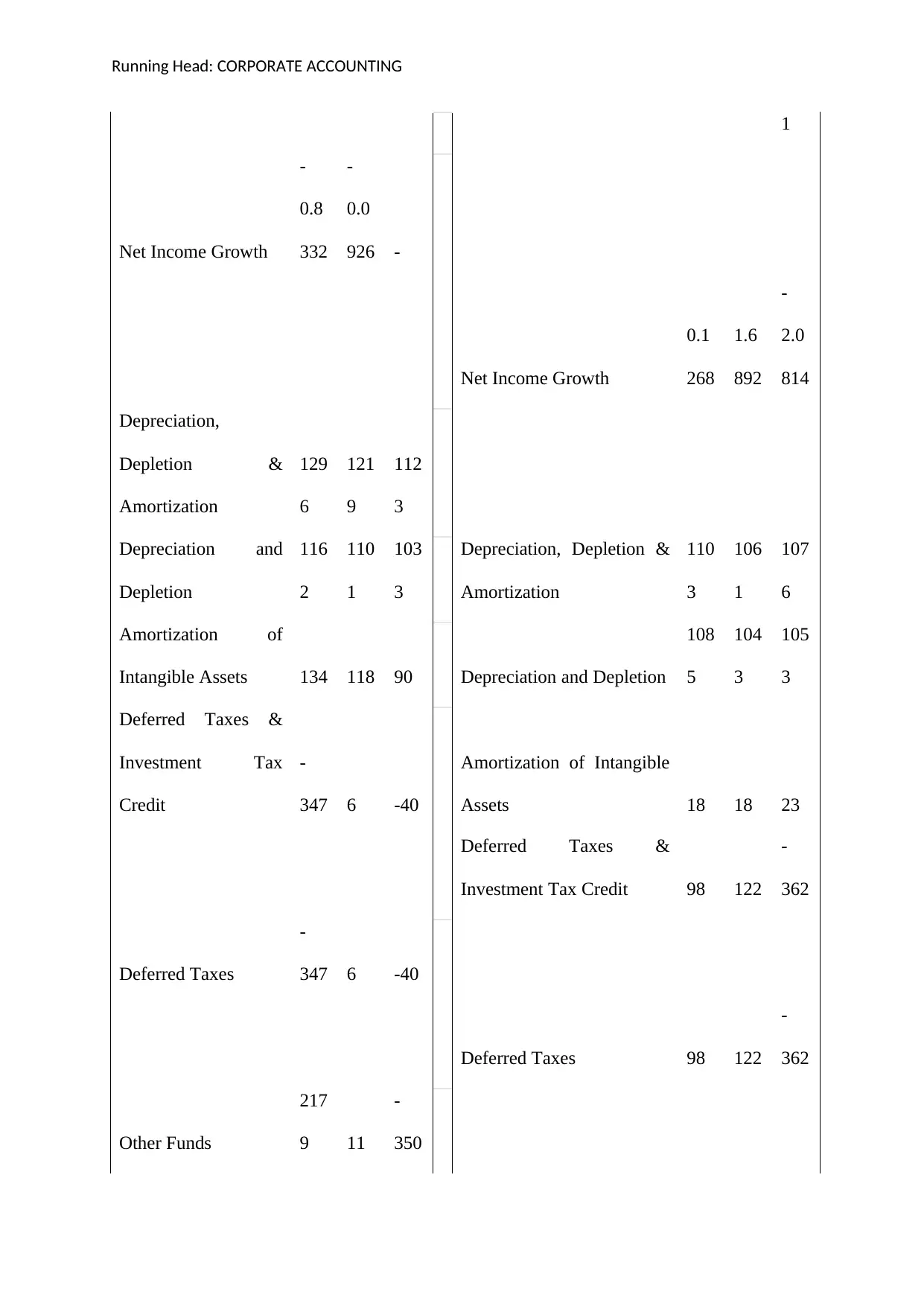
Running Head: CORPORATE ACCOUNTING
1
Net Income Growth
-
0.8
332
-
0.0
926 -
Net Income Growth
0.1
268
1.6
892
-
2.0
814
Depreciation,
Depletion &
Amortization
129
6
121
9
112
3
Depreciation and
Depletion
116
2
110
1
103
3
Depreciation, Depletion &
Amortization
110
3
106
1
107
6
Amortization of
Intangible Assets 134 118 90 Depreciation and Depletion
108
5
104
3
105
3
Deferred Taxes &
Investment Tax
Credit
-
347 6 -40
Amortization of Intangible
Assets 18 18 23
Deferred Taxes &
Investment Tax Credit 98 122
-
362
Deferred Taxes
-
347 6 -40
Deferred Taxes 98 122
-
362
Other Funds
217
9 11
-
350
1
Net Income Growth
-
0.8
332
-
0.0
926 -
Net Income Growth
0.1
268
1.6
892
-
2.0
814
Depreciation,
Depletion &
Amortization
129
6
121
9
112
3
Depreciation and
Depletion
116
2
110
1
103
3
Depreciation, Depletion &
Amortization
110
3
106
1
107
6
Amortization of
Intangible Assets 134 118 90 Depreciation and Depletion
108
5
104
3
105
3
Deferred Taxes &
Investment Tax
Credit
-
347 6 -40
Amortization of Intangible
Assets 18 18 23
Deferred Taxes &
Investment Tax Credit 98 122
-
362
Deferred Taxes
-
347 6 -40
Deferred Taxes 98 122
-
362
Other Funds
217
9 11
-
350
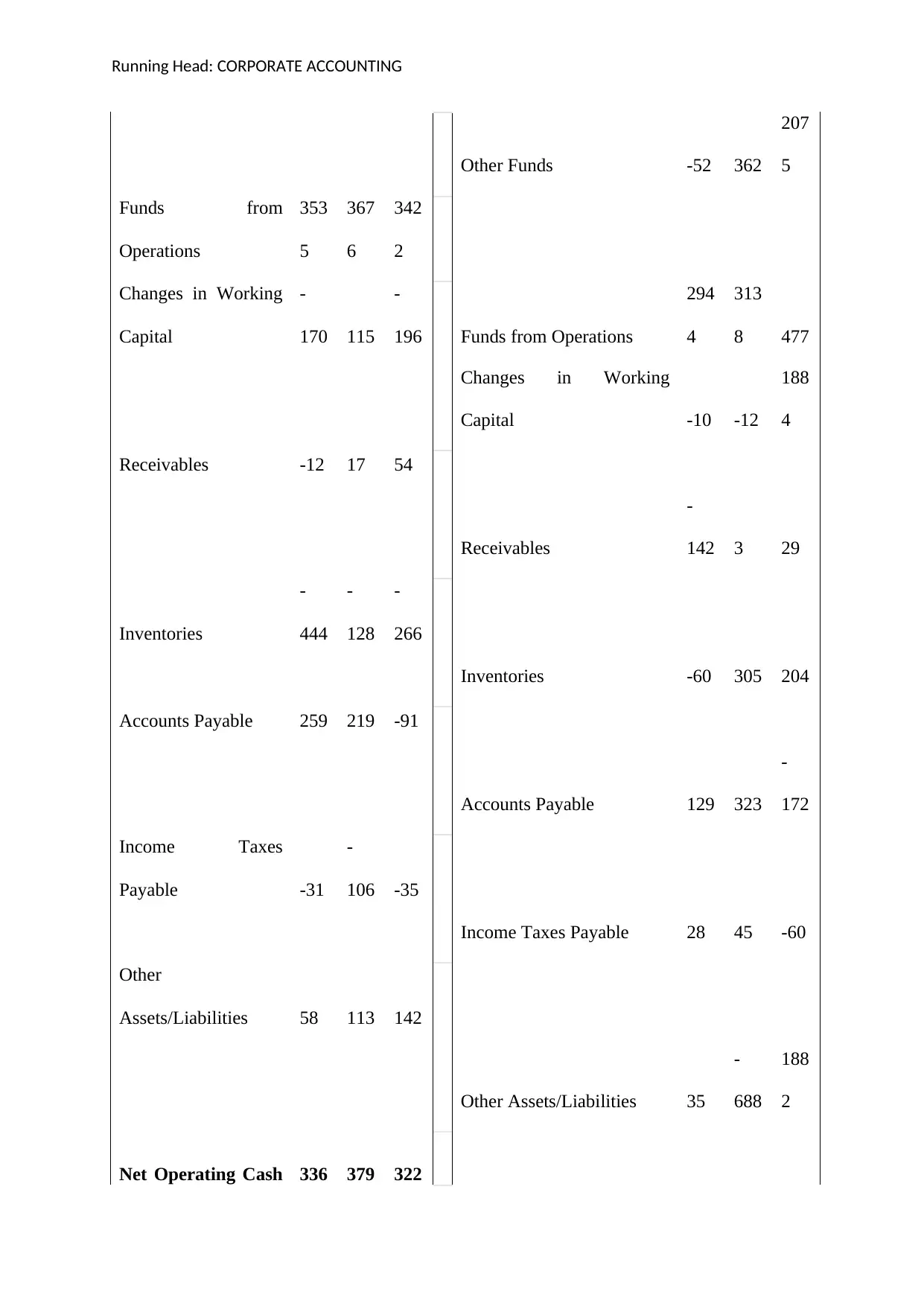
Running Head: CORPORATE ACCOUNTING
Other Funds -52 362
207
5
Funds from
Operations
353
5
367
6
342
2
Changes in Working
Capital
-
170 115
-
196 Funds from Operations
294
4
313
8 477
Changes in Working
Capital -10 -12
188
4
Receivables -12 17 54
Receivables
-
142 3 29
Inventories
-
444
-
128
-
266
Inventories -60 305 204
Accounts Payable 259 219 -91
Accounts Payable 129 323
-
172
Income Taxes
Payable -31
-
106 -35
Income Taxes Payable 28 45 -60
Other
Assets/Liabilities 58 113 142
Other Assets/Liabilities 35
-
688
188
2
Net Operating Cash 336 379 322
Other Funds -52 362
207
5
Funds from
Operations
353
5
367
6
342
2
Changes in Working
Capital
-
170 115
-
196 Funds from Operations
294
4
313
8 477
Changes in Working
Capital -10 -12
188
4
Receivables -12 17 54
Receivables
-
142 3 29
Inventories
-
444
-
128
-
266
Inventories -60 305 204
Accounts Payable 259 219 -91
Accounts Payable 129 323
-
172
Income Taxes
Payable -31
-
106 -35
Income Taxes Payable 28 45 -60
Other
Assets/Liabilities 58 113 142
Other Assets/Liabilities 35
-
688
188
2
Net Operating Cash 336 379 322
⊘ This is a preview!⊘
Do you want full access?
Subscribe today to unlock all pages.

Trusted by 1+ million students worldwide
1 out of 27
Related Documents
Your All-in-One AI-Powered Toolkit for Academic Success.
+13062052269
info@desklib.com
Available 24*7 on WhatsApp / Email
![[object Object]](/_next/static/media/star-bottom.7253800d.svg)
Unlock your academic potential
Copyright © 2020–2025 A2Z Services. All Rights Reserved. Developed and managed by ZUCOL.



